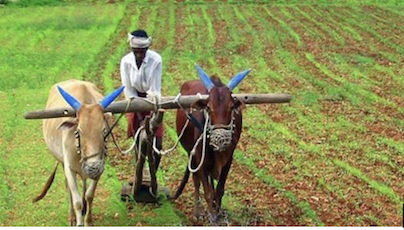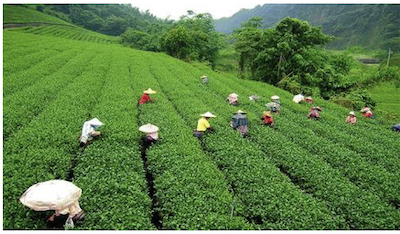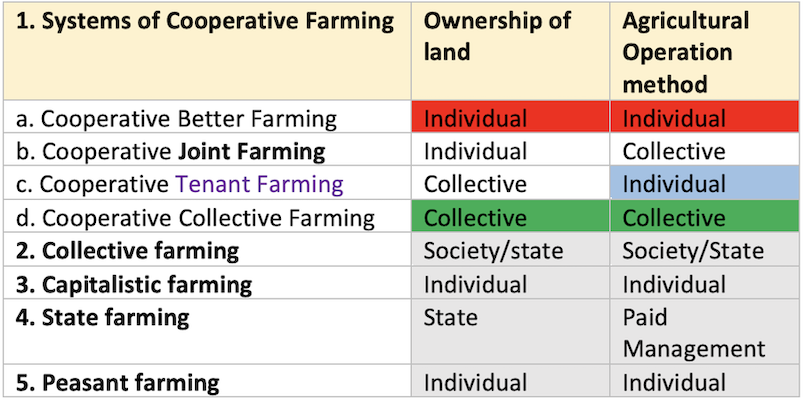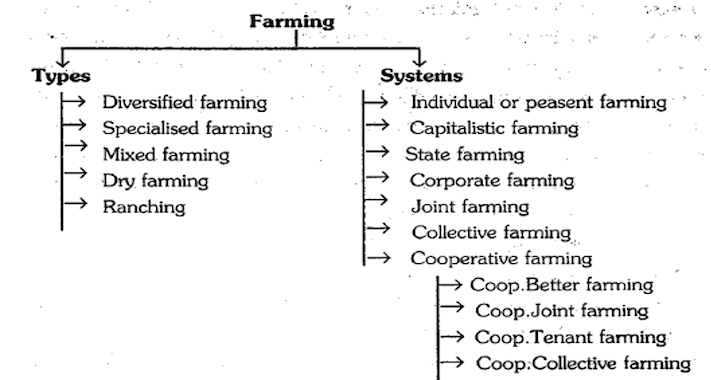🧶 Systems of Farming
Learn about Systems of Farming
- According to Johnson
“The combination of products on a given farm and the method or practices that are used in the production of the products is known as the system of farming.”
- The system of farming refers to the organizational set up under which farm is being run.
- It involves questions like who is the owner of land, whether resources are used jointly or individually and who makes managerial decisions.
- Systems of farming, which are based on different
organizational set up, may be classified into five broad categories:- Capitalistic farming
- State farming
- Collective farming
- Peasant farming
- Co-operative farming
1. Peasant/Individual Farming

- This system of farming refers to the type of organization in which an individual cultivator is the owner, manager and organizer of the farm. He makes decision and plans for his farm depending upon his resources which are generally meager in comparison to other systems of farming.
- The biggest advantage of this system is that the farmers himself is the owner and therefore free to take all types of decisions.
- A general weakness of this system is that the resources with the individual are less. Another difficulty is because of the law of inheritance. An individual holding goes on reducing as all the members in the family have equal rights in that land.
2. Joint Farming

- Here two or more than two farmers carry out the agricultural operations jointly by pooling their agricultural resources and lastly divide the produce according to the previous fixed ratio.
3. Capitalistic Farming

- In what is known as capitalistic or estate or corporate farming, land is held in large areas by private capitalists, corporations or syndicates. Capital is supplied by one or a few persons or by many, in which case it runs like a joint stock company. In such farms, the unit of organization is large and the work is carried on with hired labour; latest technical know-how is used and extensive use of machines are made and hence they are efficient.
- Examples of this type of farming are frequently found in USA, Australia, Canada and few in India too.
- Such types of farms have been organized in the states of Bombay, Madras and Mysore for the plantation of coffee, tea and rubber and sugarcane.
- The advantages of such farming are good supervision, strong organizational set up, sufficient resources etc.
- Their weaknesses are that it creates socio-economic imbalances and the actual cultivator is not the owner of the farm.

4. State Farming

- In this system farms are managed by the government. Here land is owned by the state. The operation and management are done by government officials.
- The state performs the function of risk bearing and decision making, which cultivation is carried on with help of hired labour. All the labourers are hired on daily or monthly basis and they have no right in deciding the farm policy.
- The main objective is not always to maximize the profit. Such farming system is practiced to carry out farm research work and demonstration as well as to increase the amount of quality seeds, e.g. Research farm, Seed farm, Demonstration farm etc.
- There is no dearth of resources at such farms but sometimes it so happens that they are not available in time and utilized fully.
5. Collective Farming

- The name, collective farming implies the collective management of land where in large number of families or villagers residing in the same village pool their resources Eg: land, livestock, and machinery.
- A general body/ elected committee having the highest power is formed which manages the farms. The resources do not belong to any family or farmer but to the society or collective.
- Collective farming has come into much prominence and has been adopted by some countries notably by the
RussiaandChina. - The worst thing with this system is that the individual has no voice.
- Farming is done generally on large scale and thereby is mostly mechanized. This system is not prevalent in our country.
- There are three main forms of collective farming viz. Toz, Kholkhoz and Commune.
6. Cooperative Farming

- Co-operative farming is a voluntary organization in which small farmers and landless labourers increase their income by voluntarily pooling land resources.
- According to planning commission, Co-operative farming necessarily implies pooling of land and joint management.
- The working group on co-operative farming defines a co-operative farming society as “a voluntary association of cultivators for better utilization of resources including manpower and pooled land and in which majority of the members participate in farm operation with a view to increasing agricultural production, employment and income.”
- A co-operative farming society makes one of the following four forms:

a) Cooperative Better Farming
- These societies are based on individual ownership and individual operation. Farmers who have small holdings and limited resources join to form a society for some specific purpose.
- Eg: use of machinery, sale of product. They are organized with a view to introduce improved methods of agriculture. Each farmer pays for the services which he receives from the society. The earnings of the member from piece of land, after deducting the expenses, his profit.
b) Cooperative Joint Farming
- Under this type, the right of individual ownership is recognized and respected but the small owners pool their land for the purpose of joint cultivation.
- The ownership is individual but the operations are collective.
- The management is democratic and is elected by the members of the society. Each member working on the farm receives daily wages for his daily work and profit is distributed according to his share in land.
c) Cooperative Tenant Farming
- Such societies are usually organized by landless farmers.
- In this system usually land belongs to the
society. - The land is divided into plots which are leased out for cultivation to individual members. The society arranges for agricultural requirements, Eg: credit, seeds, manures, marketing of the produce etc. Each member is responsible to the society for the payments of rent on his plot. He is at liberty to dispose of his produce in such a manner as he likes.
d) Cooperative Collective Farming
- Both ownership and operations under this system are collective. Members do not have any right on land and they cannot take farming decisions independently but are guided by a supreme general body. It undertakes joint cultivation for which all members pool their resources. Profit is distributed according to the labour and capitals invested by the members.
Summary

- According to Johnson
“The combination of products on a given farm and the method or practices that are used in the production of the products is known as the system of farming.”
- The system of farming refers to the organizational set up under which farm is being run.
- It involves questions like who is the owner of land, whether resources are used jointly or individually and who makes managerial decisions.
- Systems of farming, which are based on different
organizational set up, may be classified into five broad categories:- Capitalistic farming
- State farming
- Collective farming
- Peasant farming
- Co-operative farming
1. Peasant/Individual Farming

- This system of farming refers to the type of organization in which an individual cultivator is the owner, manager and organizer of the farm. …
Become Successful With AgriDots
Learn the essential skills for getting a seat in the Exam with
🦄 You are a pro member!
Only use this page if purchasing a gift or enterprise account
Plan
Rs
- Unlimited access to PRO courses
- Quizzes with hand-picked meme prizes
- Invite to private Discord chat
- Free Sticker emailed
Lifetime
Rs
1,499
once
- All PRO-tier benefits
- Single payment, lifetime access
- 4,200 bonus xp points
- Next Level
T-shirt shipped worldwide

Yo! You just found a 20% discount using 👉 EASTEREGG

High-quality fitted cotton shirt produced by Next Level Apparel